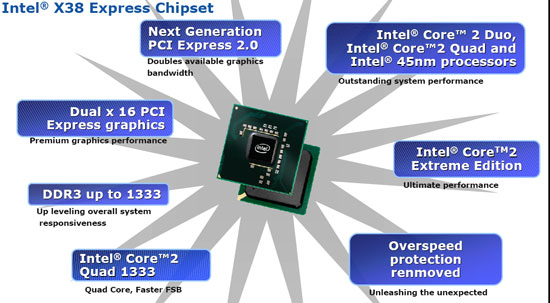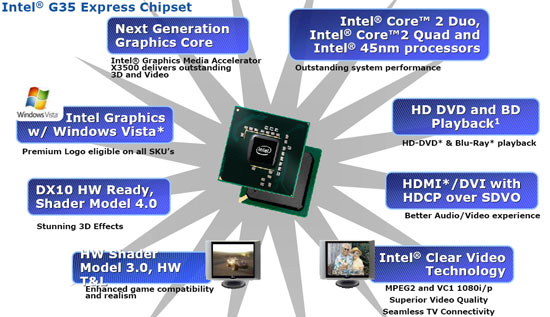Intel P35: Intel's Mainstream Chipset Grows Up
by Gary Key & Wesley Fink on May 21, 2007 3:45 PM EST- Posted in
- CPUs
X38 and G35 Chipsets - 3rd Quarter
While the X38 replacement for the 975X chipset will not launch until the 3rd quarter, Intel did provide enough information to make us wish it were here today. In addition to the feature enhancements on today's P35 chipset, X38 will add several unique features.
X38 will be the only Intel 3 series chipset to fully support dual x16 PCIe graphics. It was interesting that Intel did not specify CrossFire graphics in their literature, but we don't want to read too much into what wasn't said. The X38 will also be the first chipset to support PCI Express 2.0, which will replace the current PCIe standard. The other intriguing feature is something Intel calls "removing overspeed protection". This apparently refers to the fact X38 that will not have artificial bus speed limits on the chipset. We have seen what appeared to be artificial speed limits on Intel chipsets in the past, and an Intel chipset that can be pushed without artificial speed limits will be welcomed by all computer enthusiasts.
Other X38 features appear to be common to the P35 chipset, including full support for the 1333 processor bus and 1333 memory. X38 will also support all existing Intel processors and upcoming Penryn 45nm processors, just like other Intel Series 3 chipsets. X38 may also support other processor offerings, but Intel is not saying anything about that at this point.
G35
The third quarter will also see the introduction of Intel's G35 chipset, which will be Intel's most advanced integrated graphics chipset to date. While this may not be of huge interest to our readers, please keep in mind that the vast majority of computers sold today include integrated graphics. The G35 will be a very big deal for Intel and will be closely scrutinized by large-volume OEMs.

The G35 will be based on Intel's next-generation X3500 Graphics Media Accelerator. Full DX10 support is claimed, including support for Shader Model 4.0. For backwards compatibility X3500 also will support Shader Model 3.0 and Hardware Transform and Lighting (T&L). High Resolution DVD playback is also featured, with support for both HD-DVD and Blu-Ray playback. X3500 also is said to support HDMI and DVI. MPEG2 and VC1 1080i/p are also supported by the Intel Clear Video feature of X3500. Like the other series 3 chipsets, all current Intel processors are reported as well as future Penryn 45nm processors.
With DX10 support, all of the basic features are set in stone by Microsoft. That means that X3500 could actually be a true competitor on entry level configurations. Compared to previous Intel IGPs, X3500 certainly looks to bring some nice improvements to the platform, but we'll have to test actual performance and drivers before we can say for sure whether that's the case.










58 Comments
View All Comments
Comdrpopnfresh - Tuesday, May 22, 2007 - link
The power could be attributed to the DDR3. With it not being so mature there may be a lot of signaling going on that isn't necessary. Also- with all the new technologies, these boards simply have more going on on them. With more transistors on a cpu its is expected they will use more power- more connections and circuits on a board would mean the same. Everything is running faster too. The power consumption doesn't make sense given the lack of matching real-world performance enhancements, but as the article makes good sense in pointing out, Bios are a big contributing factor here.TA152H - Tuesday, May 22, 2007 - link
Except they ran the power tests with DDR2 on P35 based machines as well, and they were higher than P965 with the same memory. So, obviously, that isn't the cause in this instance.Gary Key - Tuesday, May 22, 2007 - link
After speaking with the board manufacturers and Intel, our original thoughts (briefings/white paper review) were confirmed that the additional circuitry required on the P35 DDR3 boards and in the MCH result in the increased power consumption on the DDR3 platform compared to the DDR2 platform. This holds true for the P35 DDR2 boards when compared to the DDR2 P965, the additional DDR3 circuity/instruction set is still active even though it is not being used. This is why you will see the DDR2/DDR3 combo boards shortly. However, the BIOS engineers believe that can work a little magic with the SpeedStep and C1E wait states to reduce power consumption, however we are talking just a few watts at best. More on this subject in the roundup, at least we hope we will have more... ;)TA152H - Tuesday, May 22, 2007 - link
Gary,Thanks, it's useful to know. Are they going to shackle the x38 with DDR2 support too?
Just confirms my earlier opinion, they should have gotten rid of DDR2 support. Intel is an interesting company, they can come out with a great product like the Core 2, and then have some monkey decide to include DDR2 and DDR3 on the P35. You never know if they'll have a clue, or not. I guess it's a good thing they make turkeys like this and the P7, otherwise we wouldn't have AMD. Although AMD might be the cause of this.
The monkey that decided to do this probably thought, "Oh, look what we can do that AMD can't". It seems to me they did that with the P7, a technological marvel way beyond AMD's capability to design, thank goodness, and the groundbreaking Itanium. Except neither one worked great. AMD's pragmatism has paid off nicely, and even though they can't realistically support DDR2 and DDR3 on the same motherboard, I don't think they really care. Of course, I'm just guessing, when a company does something this stupid, it's always difficult to understand why they did it. It would have been so simple to just have DDR3 support for the P35, and let the P965 handle the DDR2 crowd. It's perfectly adequate.
Thanks again for the information. It's disappointing, but with Intel you get used to it. They can't do everything right after all, and still be Intel.
strikeback03 - Wednesday, May 23, 2007 - link
There might be a more practical reason, such as lack of production capability for DDR3 or HP and Dell threatening to use VIA chipsets instead of P35 in order to keep using DDR2 and keep their prices competitive. I doubt consumers would like their prices increasing by a few hundred dollars for no noticeable performance improvement. And if they only keep the computer 3 or 4 years they will probably spend less on energy than on that DDR3.Who knows about X38, I'd guess DDR2 support won't disappear until the chipset revision for Nehalem.
TA152H - Wednesday, May 23, 2007 - link
Well, I agree if P35 were the only choice from Intel, this would be the case, but again, would you buy VIA if you could get a P965? I wouldn't. If the P965 were a lousy, and seriously obsolete chipset, yes, sure, you'd have to come out with something that replaced it. But they could have easily validated it for FSB of 1333, and at the point the only thing really new in the P35 would be the DDR3 support. So, why would you need it?I was going to get the P35 rather than the x38 because I figure x38 will be even more of a power hog considering the, to me, useless features it has. I don't plan on getting two high-end video cards, and I don't think I will run anything that requires twice the performance of the current PCI-E, but if they drop the DDR2 support, it might the one to go after. If you ever look at an Athlon 64 CPU, you can see the memory controller is simply enormous, so dropping it on the x38 could be significant. With it being high end, they may decide DDR2 isn't a high end technology so they drop it. I hope so.
JarredWalton - Monday, May 21, 2007 - link
Could be the Vista factor? I dunno what else to think about the power numbers.XcomCheetah - Wednesday, May 23, 2007 - link
Could you do a little testing on it... why so high power numbers..Secondly if i remember correctly the power number difference between 680i and P965 chipsets was greater than 20W.. but in your current tests the difference is pretty small.? So any guess what has caused this positive change.?
Reference
http://www.anandtech.com/cpuchipsets/showdoc.aspx?...">http://www.anandtech.com/cpuchipsets/showdoc.aspx?...
http://www.xbitlabs.com/articles/chipsets/display/...">http://www.xbitlabs.com/articles/chipsets/display/...
current power numbers on Anandtech
http://www.anandtech.com/cpuchipsets/showdoc.aspx?...">http://www.anandtech.com/cpuchipsets/showdoc.aspx?...